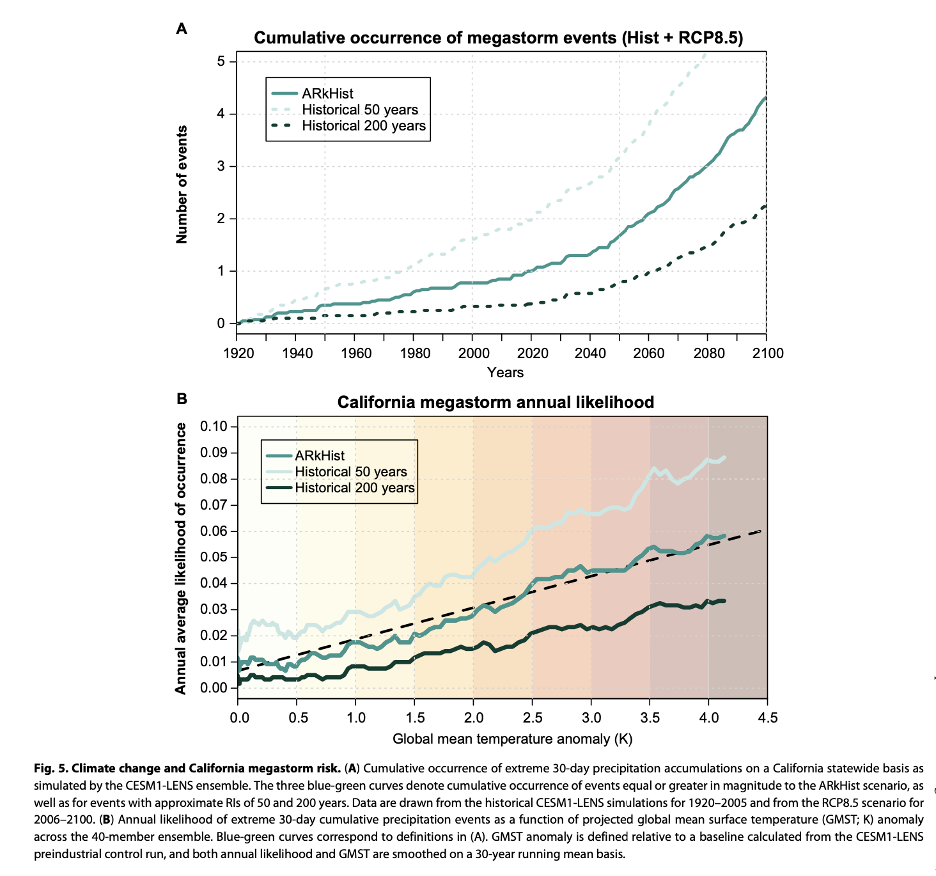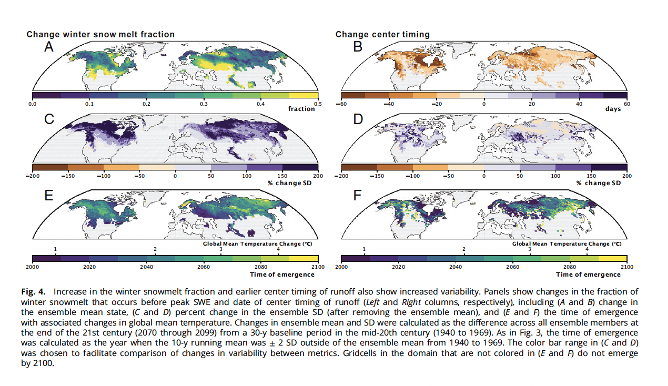Energy Development partners with the independent not-for-profit Aspen Global Modification Institute ( AGCI) to supply environment and energy research study updates. The research study summary listed below originates from AGCI Neighborhood Science Supervisor Elise Osenga A complete list of AGCI’s updates is readily available online at https://www.agci.org/solutions/quarterly-research-reviews
California is presently living out the old expression, “It never ever rains however it puts.” Following years of extreme dry spell throughout the western United States, climatic rivers started sweeping into the state last December, bringing extreme rain and snowfall Throughout the brand-new year and into the following months, storms continued to knock both Northern and Southern California with extreme rainfall.
This March, rainstorms triggered flooding, mudslides, and a levee breach at low elevations. In California’s Sierra Nevada variety, snowpack reached as much as 269 percent of “typical” in some areas by the end of February (compared to 1991-2020), with severe snowfall collapsing structures and closing highways. Issue is likewise increasing that this year’s deep snow might produce a lot more extreme flooding as warmer spring temperature levels develop snowmelt overflow and rainfall switches from snow to rain at greater elevations.
This is a far cry from 2022, when California taped its driest January, February, and March in over a century, and dry spell records were set throughout the western U.S. Comparable patterns are observable around the globe. The European Alps have actually seen decreasing typical yearly snow cover considering that 1971— a pattern unmatched in the last 600 years. Multi-year dry spells have actually likewise developed difficulties in South America (although heavy snows in July 2022 brought some relief to the Andes in Chile and Peru).
Snowpack is of utmost issue in mountain neighborhoods, where it impacts whatever from flower blossoms to wildlife survival and from leisure economies to local and farming water products. As the effects of environment modification heighten, specialists anticipate essential shifts in mountain hydrologic cycles, with effects for snow-reliant individuals and communities. Comprehending what those changes will appear like is a complex difficulty. California can work as a case research study to assist link the dots in between increasing temperature levels and local climatic patterns and to fix up projections of a future that brings both more severe dry spells and more severe floods.
Climatic rivers and megafloods in a high-risk future
Among the biggest factors of winter season rainfall is the season’s pattern of climatic rivers Passages of air which contain high quantities of water vapor, climatic rivers circulation from near the equator to greater latitudes, generally bringing high wind speeds and heavy rains or snow– particularly when they come across mountainous surface.
Current research study from Huang et al. (2022) alerts that environment modification effects to climatic rivers in the Pacific might integrate with a warming-driven shift in rainfall falling as rain instead of snow to increase the possibility of enormous flooding in California. Running ARkStorm 2.0, a catastrophe situation program for California, and utilizing different future environment conditions, Huang et al. discovered that for each 1 degree Celsius boost in international climatic temperature levels, California saw a quick boost in the possibility of a historical megaflood on par with California’s Great Flood of 1861-1862 (Figure 1).

Warmer temperature levels and increased flood danger are connected by both the strength of rainfall occasions and whether the rainfall falls as rain versus snow. Warmer air can hold more water vapor than cool air, and this research study discovered that as the environment warms, more climatic rivers will bring moisture loads that can create severe rainfall in the western U.S.– a finding supported by other research studies, consisting of Kirchmeier-Young and Zhang (2020 ), Michaelis et al. (2022 ), and Corringham et al (2022 ).
Additionally, flood danger connected with extreme rainfall occasions might be regionally intensified by the effects of warmer temperature levels. Huang et al. discovered warming temperature levels were connected with a higher percentage of the increased rainfall falling as rain instead of as snow. Under a high-emissions environment modification trajectory, the possibility of a megaflood on par with the Great Flood of 1861-1862 more than triples by 2060, marking a 600 percent boost in danger.
Fixing up a future that is both wetter and drier
How does a more flood-prone future square with research studies that anticipate a drier future for California and in other places and the oft-discussed “ aridification of the American West“? Once again, climatic rivers and local warming contribute.
Research Study from NASA suggests that although warmer air temperature levels might add to wetter and more extreme climatic rivers, the overall number of climatic rivers bringing rainfall (of any amount) to the western U.S. might reduce– implying less substantial, water-providing storms. When meteorological dry spells (dry spells brought on by second-rate rainfall) do take place, they’re most likely to be intensified by the warming environment, with effects to both summertime and winter season hydrologic cycles.
So what will these modifications suggest for future snowpack? A current research study by Weider et al. (2022) jobs snowpack volume might decrease over the coming century throughout the Northern Hemisphere. This research study examined prospective modifications to seasonal snow cycles in several mountainous areas by utilizing a set of 40 simulations from a worldwide environment design to much better comprehend the series of possibilities. Comparing forecasts for 2070-2099 to a 1950-1969 standard, the scientists categorized locations where higher than 3 cm of snow existed for more than 3 months at a time.
They discovered that warmer future environment situations were connected with thinner and less extensive snowpack by the year 2100, although modifications to snowpack were not equally dispersed throughout the hemisphere. This decrease in snowpack remained in turn connected with a reduction in the variety of days with freezing temperature levels, resulting in a much shorter snow season. In addition, Weider et al. discovered a shift in timing, with more overflow and peak streamflow previously in the fiscal year and a higher portion of snow melt taking place prior to the peak snow water equivalent (SWE) for previous years (Figure 2). These timing modifications develop difficulties for water management.

Figure 2. These maps from Weider et al. (Figure. 4 in the paper) compare designed modifications in the quantity of winter season snow melt taking place prior to peak SWE (a proxy for date of peak snowpack) from 2000 to 2100 [snow melt fractionâleft] and the point in the year at which half of yearly streamflow has actually happened[change center timing-right] By 2100, a bigger portion of snow melt takes place previously in winter season, and overflow shifts to previously in the year.
Expecting 2100, a research study by Rhoades et al (2022) likewise jobs decreasing snowpack within the American Cordillera, a series of range of mountains throughout western North and South America that consists of California’s Sierra Nevada. The research study compared high-resolution designs to recognize occasions where SWE fell listed below the 30th percentile compared to typical historic snowpack. Rhoades et al. discovered that parts of the Cordillera regularly fell under low- to no-snow worths for the 2nd half of this century, with the low-snowpack pattern starting to become early as 2025. Comparable to Weider et al.’s findings, modifications to the Cordillera snowpack were incorporated part to a boost in temperature level, which equated into less days listed below freezing and a bigger percentage of rainfall falling as rain instead of snow.
As kept in mind by Weider et al., warming-driven shifts in amount and timing of snowmelt develop difficulties for water supervisors, since when a bigger percentage of overflow originates from rain rather of snow, timing of water products ends up being less foreseeable. In addition, there is much still to discover relating to more comprehensive cascading effects throughout environmental and freshwater systems and how these associate with human systems (consisting of food production, leisure, and water quality).
Getting ready for the future
Jointly, these research studies paint an image of a future California marked by less snow usually than in historical durations, stressed by episodic severe rainfall occasions. The magnitude and speed of modifications might be identified by emissions paths, however several research studies reveal that even under low-emissions situations, California and other areas based on snowpack for their water will deal with conditions for which historic records can not supply a design template.
As water products connected to snowpack are predicted to end up being less foreseeable in amount and timing, Rhoades et al. highlight the increased significance of adaptive water storage facilities and ingenious management techniques, especially for areas that do not have such facilities. On the other hand, Huang et al.’s forecast of increased megastorms shows a various type of difficulty for water facilities and building regulations: readiness for floods and severe rainfall occasions. Proactive thinking and developing for both wetter and drier conditions might assist in preparing for a future that varies from the past.
Wieder et al. highlight the requirement to believe beyond human facilities, keeping in mind that comprehending feedbacks in between environmental systems and snowpack will be important to efficient adjustment techniques for mountain neighborhoods. Rhoades et al. likewise highlight the significance of establishing “conceptual structures”– analytical techniques that recognize connections in between system variables.
Whether getting ready for dry spell or excess water, findings from throughout all research studies suggest that high-emissions situations will speed up and worsen hydrologic modifications. Rhoades et al. discover that the rate of carbon emissions figures out how quickly low- to no-snow conditions emerge, while Huang et al. discover that danger of severe flooding increases with each degree of climatic warming, even when the environment has actually currently warmed. Corringham et al. likewise discover that effects in the western U.S. vary by environment situation: the ~$ 1 billion/year typical costs on climatic river-related flood damage over the previous 40 years doubles under an intermediate-emissions situation (RCP4.5) however more than triples under a high-emissions situation (RCP8.5). As a result, the speed and scale of environment warming will play a substantial function in figuring out reoccurrence of devastating occasions in the coming years. Jointly, these research studies suggest that effective environment mitigation activities performed now can significantly minimize the intensity of future effects from climatic rivers, floods, and dry spells.